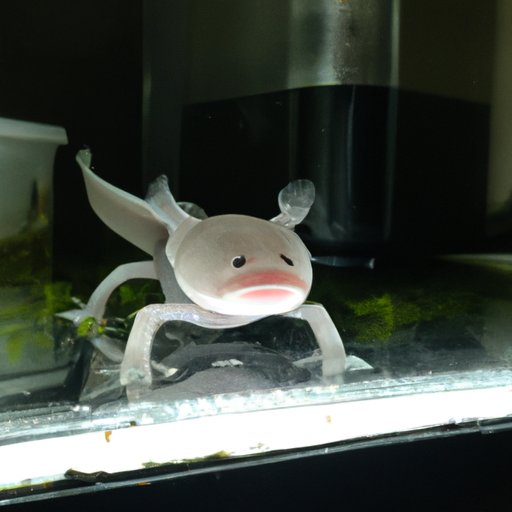Introduction
Axolotls are amphibians that are native to Mexico. These unique creatures have become popular pets due to their unusual appearance and relatively easy care requirements. Taking care of an axolotl requires regular cleaning, a balanced diet, appropriate lighting, and regular vet visits. In this article, we will explore each of these topics in detail to ensure your axolotl receives the best possible care.
Provide a Clean Tank
The first step to taking care of an axolotl is to provide a clean tank. Regular tank maintenance is essential to ensure your axolotl stays healthy. To clean the tank, start by removing all decorations, as well as any waste or uneaten food. Then, use an aquarium vacuum to remove any debris from the substrate. Finally, rinse the decorations with hot water before returning them to the tank.
Create a Balanced Diet
It’s important to offer your axolotl a variety of food sources to ensure they receive all the necessary nutrients. Offer a combination of live and frozen foods such as bloodworms, brine shrimp, and earthworms. Additionally, you can feed sinking pellets specifically designed for axolotls. It’s also important to monitor your axolotl’s food intake to ensure they don’t overeat.
Monitor Water Quality
To keep your axolotl healthy, it’s important to monitor the water quality regularly. Test the pH, ammonia, and nitrite levels weekly using a testing kit. Additionally, maintain the water temperature between 18–20°C (64–68°F). If any of these parameters are outside of the ideal range, take steps to correct them immediately.
Provide Appropriate Lighting
Axolotls should be exposed to low wattage lightbulbs for 8–12 hours per day. This helps to simulate natural light cycles and provides beneficial UVA and UVB rays. However, it’s important to avoid exposing your axolotl to direct sunlight, as this can cause stress and even death.
Handle Carefully
When handling your axolotl, it’s important to support their body with both hands. Avoid squeezing too tightly as this can cause injury. When transporting your axolotl, use a covered container with holes for ventilation. This will help to prevent escape and minimize stress.
Schedule Regular Vet Visits
Finally, it’s important to schedule regular vet visits for your axolotl. Regular checkups can help to identify any health issues early and ensure your pet is receiving the best possible care. When selecting a vet, make sure they have experience treating amphibians. This will help to ensure your axolotl receives proper treatment.
Conclusion
Taking care of an axolotl requires regular cleaning, a balanced diet, appropriate lighting, and regular vet visits. By following the steps outlined in this article, you can ensure your axolotl receives the best possible care. With the right care, your axolotl can live a long and healthy life.


